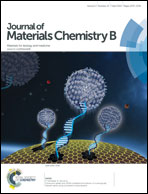Engineered ECM-like microenvironment with fibrous particles for guiding 3D-encapsulated hMSC behaviours†
Abstract
The alginate hydrogel has been used as an attractive scaffold for tissue regeneration. In particular, its simple cross-linking, high water absorption, and biocompatibility have facilitated its utility in regulating the interaction with cells or organs. However, three-dimensional (3D) networks of the alginate hydrogel do not provide fibrous anchorage sites such as the collagen fibres in the natural extracellular matrix (ECM). This has partially limited the survival of anchorage-dependent cells in the 3D hydrogel environment. In this report, we established a hybrid hydrogel containing fibrous particles (FP) that closely mimics the ECM. The RGD peptide-coupled FP (R-FP) has a wide range of distribution and was homogeneously dispersed in the hydrogel. The encapsulated human mesenchymal stem cells in the hydrogel could bind to the R-FP presenting remarkable spreading morphology, augmented viability and differentiation. These findings may elicit the significance of a physical interaction in which the R-FP provides structural and biological cues to the cells. This strategy can be widely applicable to a variety of hydrogel systems.


 Please wait while we load your content...
Please wait while we load your content...